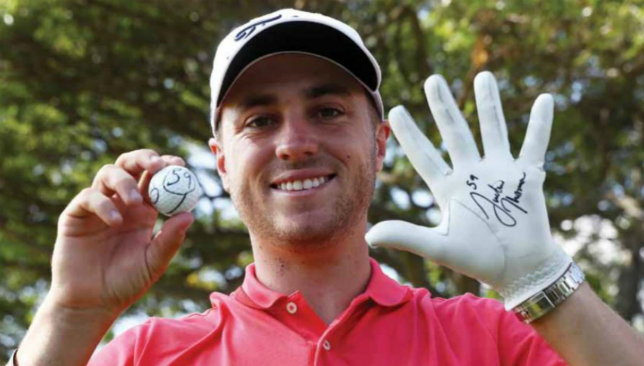
There was a time when ‘breaking the 60 barrier’ in golf was considered the ultimate achievement. Until 1991, only one man had been able to do the seemingly impossible – Al Geiberger at the 1977 Memphis Classic.
In 1991, Chip Beck joined him on that exclusive list and by the turn of century, David Duval became the third member after a blistering round of 59 at the 1999 Bob Hope Chrysler Classic. Duval was having such a fantastic ball-striking day, he is said to have made nine of his 12 birdies from inside four feet.
Since 2010, there have been a slew of 59s on the PGA Tour. In the space of two months, Paul Goydos and Stuart Appleby shot the magic number. Jim Furyk then shot a 59 in the 2013 BMW Championship, and last year at the Travelers Championship, upped the ante with a 58.
And we are not even a month into 2017 and there have already been three 59s – Justin Thomas at the Sony Open, Adam Hadwin in last week’s Career Builder Challenge and Woody Austin in a Champions Tour event.
On the LPGA Tour, there has only been one 59 – by Annika Sorenstam in the 2001 Standard Register PING – while there have been none on the European and Asian Tours. The Japan Golf Tour has witnessed two sub-60 rounds – including a 58 by Ryo Ishikawa in the 2010 The Crowns.
Not counting the minor Tours, there have been seven sub-60 scores since 2010. So, the big question is, has the game become easier? What has changed so dramatically that we now have so many 59s? Are players of today much better than the Hogans, Palmers and Nicklaus’?
Well, the biggest reason for that is the golf ball. I am not necessarily saying that because the ball now travels a lot further, it makes scoring easier. If that was the case, guys like Dustin Johnson and Rory McIlroy would have dominated that list.
Instead, Furyk, one of the shortest hitters on the Tour, is the only one to have done it twice. However, the one real binding factor between all these recent 59s is that all of them have been shot with solid core balls, which first came into the market in 2001.
They do travel further, but more importantly, the modern balls can produce more spin and behave much more to the expectations of the players on the greens. The modern ball is also perfectly made and extremely aerodynamic.
Gone are the days when professionals would carry a circular metal loop in the bag and Epsom salt, testing each ball for shape and balance the night before. The second big reason is the conditions of the golf courses. The advancements made by the agronomy teams ensure that most tournament courses are in pristine conditions.
We no longer have patchy greens and fairways which were once an expected part of the set-up and players were never sure how the ball would react. It also helps that golf clubs and Tours are now more open to the idea of pros shooting low numbers.
Even until the late 1990s, many golf clubs would take great pride if their course yielded more bogeys than birdies. That has changed. Courses, committees and Tours now understand that fans would rather see a professional making a birdie than struggle.
A 59 is a great way of ensuring that their event becomes unforgettable for fans. Obviously, the equipment has also improved. Let’s not even talk about the driver, which has increased the average driving distance on the Tours by at least 20 yards in the last 10-15 years.
Let’s just concentrate on the wedges and putters. The square grooves on wedges were so good in controlling the ball that the governing bodies actually had to ban them. If you look at the putters, the alignment aids and the quality of inserts have helped reduce the scoring.
One more reason is that golfers today are much fitter and athletic these days. They are also much better prepared for life as a professional – following a regulated and useful career as a junior.
From a very early age, they are now helped by a team, which would comprise a manager, a psychologist, a nutritionist and a fitness trainer.
Compare that to yesteryear, when someone like Ben Hogan went his entire career alone, if you do not count his caddie.
NOT AN EASY START FOR EASTON
Greg Eason's low score was 90 in his first three rounds of 2017.
— Web.com Tour (@WebDotComTour) January 24, 2017
With help from Rhein Gibson, he shot a 68 on Monday ...
Bogey-free. pic.twitter.com/HeeZvQsQQU
It’s not the best way to become famous, but Greg Eason became the talk of the golfing world last week when he followed his rounds of 91 and 95 at the Web.com Tour’s Bahamas Great Exuma Classic with a 90 in the first round of the Great Abaco Classic, also in the Bahamas.
That round of 90 on Sunday – the two Bahamas events are Sunday to Wednesday – contained a decuple bogey on the par-5 18th. That’s 10-over par – the highest score ever recorded on a hole in a Web.com event.
It wasn’t the worst score recorded for a single hole in professional golf – John Daly had an 18 on the par-5 sixth hole at the 1998 Bay Hill Invitational, while Ray Ainsley was 15over par 19 on the par-4 16th hole at Cherry Hills in the 1938 US Open.
However, credit to Eason, who was ranked the third best amateur in the world in 2014; he bounced back with a 68 the next day. The 22-shot swing also an all-time best on Web.com Tour.